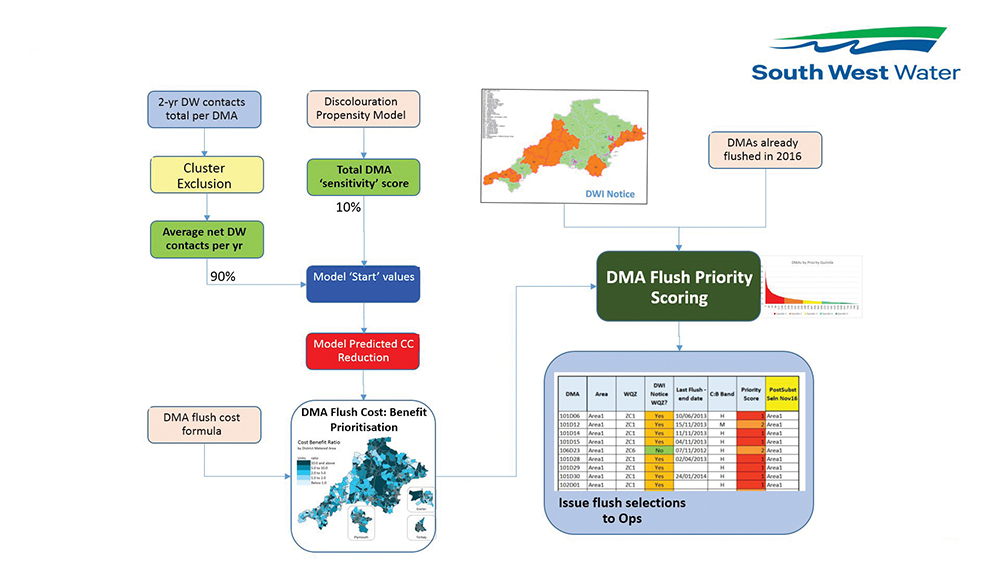Twenty years ago management of water distribution systems moved from major ‘Section 19’ rehabilitation programmes to a more business as usual
By Mark Randall-Smith, WSP
The scope of DOMS extends from the water treatment works outlet to the customer’s tap and they inform activities both at a strategic level and as part of day-to-day operations. Much of the focus has been on managing problems of discolouration.
The DOMS process has clearly driven innovation: novel techniques and approaches have emerged including trunk main conditioning, ice pigging, and better monitoring and control through ‘smart networks’. However, the relatively humble practice of proactively flushing mains is also still used by many companies. This works by increasing network flows in a controlled manner, to remove accumulated material and hence the risk of uncontrolled remobilisation. The problem is that maintaining all DMAs in a clean state all of the time would be prohibitively expensive, so a process of prioritising and programming is required.
Traditionally such processes would consider the history of customer contacts about discolouration and perhaps network water chemistry. These will often be the best information available, but may not predict the greatest unrealised risks. Discolouration will only occur if there is a suitable hydraulic trigger such as an exceptionally high demand, major burst or operational cause. In the absence of any of these it is quite possible that there won’t have been an event which means that historic contacts will not reflect the risk of what could happen.
Working together with South West Water (SWW), WSP has developed a risk modelling approach that allows this ‘unrealised risk’ to be taken into account when prioritising DMAs for flushing. The model utilises the outputs from another WSP innovation developed some years ago in collaboration with researchers at Exeter University – the Discolouration Propensity Model (DPM) – which we have now applied to the vast majority of potable water mains within the SWW region. DPM returns a suite of discolouration risk scores for individual pipes, including one that indicates how sensitive each pipe is to flow changes in the network, partly linked to its own everyday ‘self-cleansing’ state and partly down to its position. Pipes with a high sensitivity risk factor should be kept clean as a priority. Aggregating the risks to DMA level allows an element of prediction to be incorporated into the process to prioritise DMAs for flushing.
The flushing model uses a weighted average of past contacts and the DPM scores to prioritise DMAs. Further analysis has identified the average mitigation achieved by flushing, as assessed by the numbers of contacts in a period before and after; and the average rate at which contacts then increase again after flushing. Informed by this and knowing the date when each DMA was last flushed, the model can generate a profile that allows the benefits of different flushing strategies and DMA selections to be evaluated. Combined with a cost model these can be prioritised using cost benefit analysis.
We have to date applied the flushing model with SWW to help develop cost-effective DMA flushing programmes during AMP6, and to inform flushing strategies for the PR19 business plan. The ongoing flushing activities are now benefiting from the use of hand-held HACH turbidity monitors which measure and log turbidity in NTU units – this is a vastly improved approach compared with the colour grade cards used previously, and has the added advantage of providing datasets against which we should be able to calibrate DPM for specific supply areas. We have started analysing the data with this objective in mind which should further increase the confidence of future predictions.
The availability of discolouration risk scores from DPM at individual pipe level also allows us to take the flush model innovation one step further. Once a high-risk DMA has been selected we can identify those high-risk pipes which should definitely be flushed to remove the majority of risk, but without the cost and time implications of flushing the entire DMA. In trials carried out to date we have found that typically 80% of the predicted DMA risk can be removed with 30% – 40% of the full DMA cost. We have termed this approach ‘pareto flushing’ and expect to see it playing an increasing role in the flushing programmes carried out by SWW in the future.
www.wsp.com
of Distribution Operations and Maintenance Strategies (DOMS). The expectations for these were first set out by the Drinking Water Inspectorate in 1998 and they have been a familiar feature for the UK water industry ever since.






